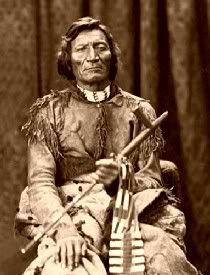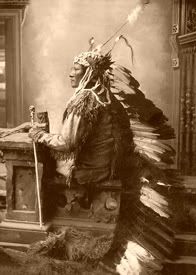|
-
31st May 10, 10:54 AM
#31
 Originally Posted by ThistleDown

 or an early form of ballcap? In fact, it was a fore-and-aft.
Would this be ala Sherlock Holmes. A tight fitting cap with a brim "fore and aft" and ear flaps tied up?
Edited: My bad...no it is like a Boy Scout cap which you can fold over your belt...yes?
Last edited by McElmurry; 31st May 10 at 11:00 AM.
-
-
31st May 10, 11:16 AM
#32
 Originally Posted by McElmurry

Would this be ala Sherlock Holmes. A tight fitting cap with a brim "fore and aft" and ear flaps tied up?
Edited: My bad...no it is like a Boy Scout cap which you can fold over your belt...yes?
The "fore and aft" is what Mr Holmes is popularly seen as wearing out-of-doors. The "deerstalker" has brims to and fro, as well, and ear flaps. A very practical form of headgear in the Highland climate. Ears nice and warm with the flaps down. If tied under the chin the heavy winds don't lift it off your head. The rear brim carries the water away over your collar. The fore brim keeps the water off your face and even protects your eyes from the brightness of the rain drops. 
Rex
-
-
31st May 10, 11:27 AM
#33
Wikipedia strikes again. It lists Fore and Aft under Garrison caps.
-
-
31st May 10, 12:28 PM
#34
 Originally Posted by Woodsheal

Myself, I find it somewhat astonishing that the kilt just totally died as an everyday, common man's working garment (if it truly did) after three or four centuries in such a role. What prompted such a change?
Brian, may I tap your knowledge as a re-enactor? What caused the aboriginal of the American prairies to, within the last forty years of the 19C and the first ten or so of the 20C, completely change his manner of dress? Paintings and photographs of the period show him something like this one of Cheyenne Dull Knife in 1873.

Or this one of Sioux Rain-in-the-Face, he who was at the Battle of Bighorn

I'm not trying to sidetrack us here, but trying to draw some sort of parallel that may be more easily understood.
Rex
-
-
31st May 10, 12:48 PM
#35
 Originally Posted by McElmurry

Wikipedia strikes again. It lists Fore and Aft under Garrison caps.
This is why I tell my students not to use Wikipedia. ;-)
A garrison/pi**cutter cap in US service originates from WWI, & if I remember correctly, is based on a similar cap worn by the Serbs. The Belgians also wore a similar cap, as well as the British "tent cap" which was (and still is) worn by mounted regiments.
T.
-
-
31st May 10, 03:24 PM
#36
 Originally Posted by ThistleDown

Brian, may I tap your knowledge as a re-enactor? What caused the aboriginal of the American prairies to, within the last forty years of the 19C and the first ten or so of the 20C, completely change his manner of dress? Paintings and photographs of the period show him something like this one of Cheyenne Dull Knife in 1873.

Or this one of Sioux Rain-in-the-Face, he who was at the Battle of Bighorn

I'm not trying to sidetrack us here, but trying to draw some sort of parallel that may be more easily understood.
Rex
Contact with Europeans, and the new trade that swiftly developed between the two groups, rapidly altered the life styles of the natives. This was seen among the Eastern Woodland nations as early as the 1600s. The Indians quickly became dependent upon the manufactured European items they received via the fur trade: steel-bladed tools and weapons, firearms, iron cooking vessels, woolen blankets, the list goes on. Native garb was also affected over time as mass-produced items replaced traditional ones as "civilization" marched westwards.
I'm not sure that the experience of New World inhabitants being rather suddenly impacted by technological newcomers was mirrored in the Highlands. The Highlands were considered somewhat remote, but were never cut off from the remainder of Europe, and trade was an ongoing state of affairs, was it not?
Brian
"They who can give up essential liberty to obtain a little temporary safety, deserve neither liberty nor safety." ~ Benjamin Franklin
-
-
31st May 10, 06:35 PM
#37
I believe one of the factors that brought about the fairly rapid demise of the kilt was the desire of the average Highlander to be seen as something other than savage or backward. This totally human desire to "fit in" coincides with the availability of cheap, European style clothing. The rag trade-- selling used clothing-- was rampant throughout the 19th and early 20th century Britain, and virtually the whole of the working class at this time wore second hand clothes. The economics of used clothing would not be lost on even the most humble crofter: If he wove 8 yards a week he could sell all of it, and buy a pair of trousers or, he could weave 8 yards, turn four yards into a kilt and be left with only four yards of goods to sell.
This, coupled with the other societal and industrial changes already mentioned, I believe would have hastened the demise of the kilt as an item of civilian attire.
-
-
31st May 10, 09:21 PM
#38
 Originally Posted by Woodsheal

Contact with Europeans, and the new trade that swiftly developed between the two groups, rapidly altered the life styles of the natives. This was seen among the Eastern Woodland nations as early as the 1600s. The Indians quickly became dependent upon the manufactured European items they received via the fur trade: steel-bladed tools and weapons, firearms, iron cooking vessels, woolen blankets, the list goes on. Native garb was also affected over time as mass-produced items replaced traditional ones as "civilization" marched westwards.
I'm not sure that the experience of New World inhabitants being rather suddenly impacted by technological newcomers was mirrored in the Highlands. The Highlands were considered somewhat remote, but were never cut off from the remainder of Europe, and trade was an ongoing state of affairs, was it not?
Thanks, Brian, that is wonderful information.
There is a certain parallel to be drawn. You are of course correct that there was trade between the continent and the Highlands prior to the last half of the 18C, but that trade was not between the common people of either. In another thread we were discussing the clothing of the shopkeeping and merchant classes in the Highlands, but the merchant class was never a kilted one and they were the men who had contact with the Low Countries, the Hansiatic League, France and England.
What I was trying to show here is the quite sudden change that took place in a native culture, its dress and, ultimately, its language when Europeans came on the scene. And Europeans from England and Edinburgh were just as foreign to the common Highlander of the 17C and 18C as were people from Hamburg or Rome.
We shouldn't try to isolate the kilt or the buckskin leggings from the cultures in which they were worn. It was the cultures of both societies that changed, with their clothing to follow.
"Native garb was also affected over time as mass-produced items replaced traditional ones as "civilization" marched westwards." That appears to have been the case in the Highlands, as well. With the construction of roads and access to the remote parts of the country, the enforced peace between neighbours, the cutting of the powers of the chiefs, the sudden loss of security for the common folk and a well-displayed attitude of disgust by everyone who came among them -- the march of "civilisation" into the Highlands -- or the central and western parts of America.
Hard on its heels came the cheap manufactured goods of the Lowlands, England and the Continent.
Rex
-
-
1st June 10, 02:50 AM
#39
Rex,
Since you brought up the First Nations, a very interesting & similar discussion occurs in Colin Calloway's "White People, Indians and Highlanders: tribal peoples and colonial encounters in Scotland and America".
T.
-
-
1st June 10, 07:56 AM
#40
 Originally Posted by cajunscot

Rex,
Since you brought up the First Nations, a very interesting & similar discussion occurs in Colin Calloway's "White People, Indians and Highlanders: tribal peoples and colonial encounters in Scotland and America".
T.
Thanks, Todd. I've read reviews but not the book. "First Nations"? Well done. For those not familiar with this term, First Nations is the collective name adopted by the aboriginal peoples of Canada.
Rex
-
Similar Threads
-
By Paul in forum General Kilt Talk
Replies: 26
Last Post: 27th November 09, 08:35 PM
-
By Phogfan86 in forum General Kilt Talk
Replies: 6
Last Post: 6th April 09, 09:56 AM
-
By Hamish in forum Contemporary Kilt Wear
Replies: 27
Last Post: 24th February 09, 07:27 PM
-
By Cayusedriver in forum General Kilt Talk
Replies: 3
Last Post: 22nd August 08, 11:14 AM
-
By S.G. in forum General Kilt Talk
Replies: 17
Last Post: 30th July 08, 03:21 PM
 Posting Permissions
Posting Permissions
- You may not post new threads
- You may not post replies
- You may not post attachments
- You may not edit your posts
-
Forum Rules
|
|
Bookmarks